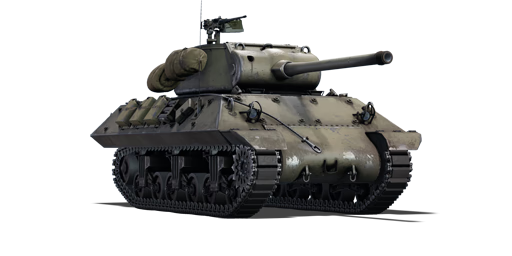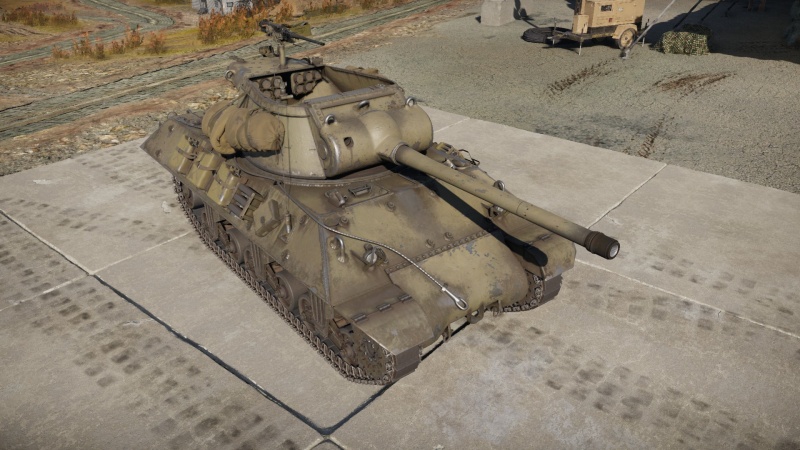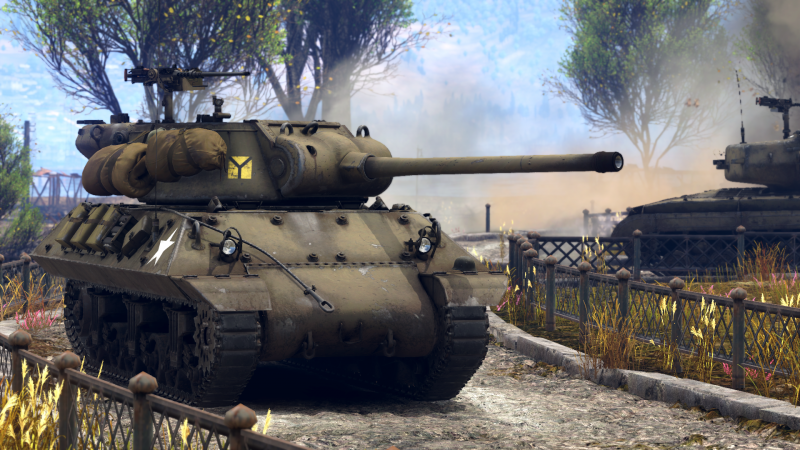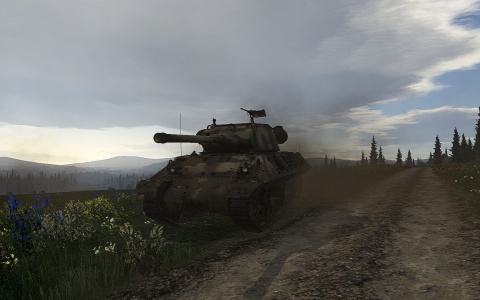M36 GMC
| This page is about the American tank destroyer M36 GMC. For other versions, see M36 Jackson (Family). |
Contents
Description
The M36 tank destroyer, officially designated as the 90 mm Gun Motor Carriage M36, was a tank destroyer used by the U.S. Army during World War II. The M36 merged the M10 tank destroyer's hull, which employed the M4 Sherman's reliable chassis and engine coupled with sloped armour, with a new turret housing the 90 mm M3 anti-tank gun. With the introduction of advanced German tanks such as the Panther and Tiger, the standard U.S. tank destroyer, the M10 GMC, was quickly becoming obsolete since its main weapon, the 3-inch M7 anti-tank gun, struggled to penetrate the thick frontal armour of these new tanks. Late in the summer of 1942, U.S. engineers started to look into the possibility of a new tank destroyer armed with a 90 mm anti-tank gun. The Ordnance Department experimented with placing the experimental 90 mm T7 anti-tank gun into the turret of an M10 tank destroyer in October 1942. Following testing, an initial order for 300 vehicles was placed. The T71 prototype was designated as the 90 mm Gun Motor Carriage - M36 GMC following standardization on June 1, 1944. The M36 tank destroyer first saw combat in Europe in October 1944, officially replacing the M10 GMC. It was also used in the Korean War.
Introduced in Update 1.49 "Weapons of Victory", the M36 GMC saw significant upgrades in firepower over the earlier M10 GMC. Dealing with more sophisticated German tanks, such as Panthers and Tigers, is significantly easier due to their increased calibre, which results in more armour penetration. Nonetheless, the vehicle is poorly armoured and open-topped, making it vulnerable to strafing by enemy aircraft. Due to minor engine modifications, the M36 GMC is substantially faster than the earlier M10 GMC, allowing the player to reach important positions much faster throughout combat.
General info
Survivability and armour
Armour type:
- Rolled homogeneous armour
- Cast homogeneous armour (Gun mantlet, Transmission area)
| Armour | Front | Sides | Rear | Roof |
|---|---|---|---|---|
| Hull | 38.1 mm (56°) Front glacis 50.8-107.8 (9-63°) Transmission housing |
19.05 mm (37°) Top 25.4 mm Bottom |
19.05 mm (42°) Top 19.05 (1-45°) Bottom |
19.5 mm Front roof 9.5 mm Engine deck |
| Turret | 31.75 mm (2-53°) Turret front 76.2 mm (°) Gun mantlet |
31.75 mm (0-21°) | 25.4 mm (2-23°) | N/A |
Notes:
- Tracks are 30 mm thick, bogies are 10 mm thick while the wheels are 20 mm thick.
- Small slivers of 5 mm armour hang off the top side hull armour, giving minuscule protections at those areas.
- Track blocks on the side hull armour allows an extra 30 mm of armour at their locations.
Being lightly armoured, the M36 GMC is very vulnerable to nearby ammorack detonations and bomb blasts.
Mobility
| Game Mode | Max Speed (km/h) | Weight (tons) | Engine power (horsepower) | Power-to-weight ratio (hp/ton) | |||
|---|---|---|---|---|---|---|---|
| Forward | Reverse | Stock | Upgraded | Stock | Upgraded | ||
| Arcade | 52 | 7 | 28.1 | 710 | 954 | 25.27 | 33.95 |
| Realistic | 48 | 7 | 442 | 500 | 15.73 | 17.79 | |
Based on the chassis of the M10 GMC, the M36 GMC has the same all-round mobility: the tank accelerates quickly and is able to reach a maximum speed of 45 km/h in a dozen of seconds. The brakes are powerful and make the M36 GMC skid rather than slow down when travelling at maximum speed. The violent braking also causes the hull to wobble, making your targeting less accurate. The reverse speed is however poor: it won't get you out of a dangerous situation quickly enough. Turning doesn't make you lose much speed as your acceleration is fast. While there is no neutral steering, turning on the spot is still easily done as it is a light vehicle: build a little speed before turning to turn even faster. The offroad mobility is good: the M36 GMC reaches 20 km/h when fording, 18 km/h when driving uphill with some speed built-up but a mere 10 km/h uphill from a stop start. The tracks are large and grant you a decent mobility on hard (solid ground, roads) and soft terrain (mud, snow, sand). Light and medium obstacles (fences, posts, bushes and small trees) are not a problem but large obstacles will reduce your mobility: avoid them. In short, the M36 GMC is agile enough to perform its combat role on all types of terrain.
Modifications and economy
The following modifications should take priority:
- M82 shot (APCBC). This will greatly improve the firepower.
- Parts. So the vehicle can repair.
- FPE, to put out fires in the event the M36 isn't done in by pyrotechnics.
- Adjustment of fire, to improve gun accuracy.
- Elevation Mechanism, to improve gun accuracy.
- Personal discretion from here. M304 shot (APCR), Engine, Horizontal Drive are all good next choices. The engine is probably the best bet if taking into RB, but less important in AB.
Armaments
Main armament
| 90 mm M3 | Turret rotation speed (°/s) | Reloading rate (seconds) | |||||||||||
|---|---|---|---|---|---|---|---|---|---|---|---|---|---|
| Mode | Capacity | Vertical | Horizontal | Stabilizer | Stock | Upgraded | Full | Expert | Aced | Stock | Full | Expert | Aced |
| Arcade | 47 | -10°/+20° | ±180° | N/A | 21.1 | 29.3 | 35.5 | 39.3 | 41.8 | 9.75 | 8.63 | 7.95 | 7.50 |
| Realistic | 14.3 | 16.8 | 20.4 | 22.6 | 24.0 | ||||||||
The 90 mm M3 is the same gun available for the Super Hellcat, the T25 or the M26 and stays reliably accurate until 800 m distance. Beyond 1,000 m the loss of accuracy becomes a real handicap. The high muzzle velocity of your shells grants you pretty flat firing trajectories and thus helps fire at moving targets from a distance. In that regard, using the "sight distance control" feature can increase your chances of successfully hitting enemy tanks.
The rotation speed of the gun is better than average compared to other tanks at the same rank or battle rating. Which makes tracking a target from a distance an easy task to perform as your targeting process is fast. Elevation and depression angles of the gun are important, allowing you to fire from unusual positions (behind a ridge, from uphill, etc.). Your reload time is similar to vehicles at the same BR, if not a little longer than average. Your recoil is important but not powerful enough to throw your gun off target after firing. Lacking a stabilizer, the tank can't reliably fire on the move.
Ammunition
The available ammunition allows for engaging all types of targets:
- M77: AP; a solid shot with an average penetration power and no explosive filler.
- M82: APCBC; a capped armour-piercing shell with a ballistic cap that has a better but still average penetration power and an explosive filler. It will destroy any armoured target it penetrates.
- M304: APCR; a composite round with a very high penetration power but no explosive filler and will only penetrate flat vertical surfaces.
- M71: HE; useful for destroying open and lightly armoured vehicles.
- M313: Smoke; useful to blind enemy vehicles that are too remote for you to disable so that you can progress towards objectives.
| Penetration statistics | |||||||
|---|---|---|---|---|---|---|---|
| Ammunition | Type of warhead |
Penetration @ 0° Angle of Attack (mm) | |||||
| 10 m | 100 m | 500 m | 1,000 m | 1,500 m | 2,000 m | ||
| M77 shot | AP | 162 | 160 | 148 | 135 | 123 | 113 |
| M82 shot | APCBC | 185 | 182 | 169 | 155 | 142 | 130 |
| M304 shot | APCR | 287 | 281 | 259 | 234 | 211 | 191 |
| M71 shell | HE | 20 | 20 | 18 | 17 | 16 | 16 |
| Shell details | ||||||||||||
|---|---|---|---|---|---|---|---|---|---|---|---|---|
| Ammunition | Type of warhead |
Velocity (m/s) |
Projectile mass (kg) |
Fuse delay (m) |
Fuse sensitivity (mm) |
Explosive mass (TNT equivalent) (g) |
Ricochet | |||||
| 0% | 50% | 100% | ||||||||||
| M77 shot | AP | 822 | 10.61 | - | - | - | 47° | 60° | 65° | |||
| M82 shot | APCBC | 853 | 10.91 | 1.2 | 14 | 137.2 | 48° | 63° | 71° | |||
| M304 shot | APCR | 1,021 | 7.62 | - | - | - | 66° | 70° | 72° | |||
| M71 shell | HE | 823 | 10.55 | 0.2 | 0.1 | 1,210 | 79° | 80° | 81° | |||
| Smoke shell characteristics | ||||||
|---|---|---|---|---|---|---|
| Ammunition | Velocity (m/s) |
Projectile mass (kg) |
Screen radius (m) |
Screen deploy time (s) |
Screen hold time (s) |
Explosive mass (TNT equivalent) (g) |
| M313 | 821 | 10.7 | 9 | 5 | 20 | 50 |
Ammo racks
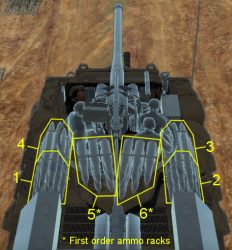
| Full ammo |
1st rack empty |
2nd rack empty |
3rd rack empty |
4th rack empty |
5th rack empty |
6th rack empty |
Visual discrepancy |
|---|---|---|---|---|---|---|---|
| 47 | 39 (+8) | 30 (+17) | 21 (+26) | 12 (+35) | 7 (+40) | 1 (+46) | No |
Notes:
- Recommended load is 21 (+26) to remove most ammo from the hull.
- Racks 5 and 6 are ready racks and take priority in being filled as well as depleted.
- Full reload speed will be realized as long as ammo exists in either ready racks. If both ready racks are empty, a penalty to reload speed will occur.
- Simply not firing when the main gun is loaded will load ammo from racks 1 to 4 into 5 then 6, as long as there is ammo present in racks 1 to 4. Firing the main gun will interrupt the loading of the ready racks.
Machine guns
| 12.7 mm M2HB | ||||
|---|---|---|---|---|
| Mount | Capacity (Belt) | Fire rate | Vertical | Horizontal |
| Pintle | 1,000 (200) | 576 | -10°/+70° | ±60° |
The turret-mounted heavy machine gun has great depression & elevation, posing a big threat to any plane that is flying too close to the M36 GMC. It can also easily penetrate lightly armoured vehicles and even the sides of some medium tanks.
Usage in battles
Play style with the M36 should be about the same as the M10. The speed is slightly better and armour is still just as thin, but it has an improved turret traverse rate and a 90 mm gun, making it able to engage targets much easier. The play style is also similar to the M18, since they have the same concept - speed and manoeuvrability with a powerful armament.
The greatest advantages of the M36 are its speed and its armament. As such, the best course of action is to make use of the speed to get to good early game positions on the map. The 90 mm gun is powerful at its BR, and it can penetrate many tanks at its BR from the front. But, this is not the case for more heavily armoured targets such as those in the IS series or the Panther series, but it can reliably kill every tank at its BR from the side in 1 to 2 shots because of the high explosive filler in the APCBC round. In addition, most enemy tanks can reliably penetrate you from the front, as the M36 does not have thick armour. Your armour can only protect you when a shell hits it at an extreme angle, or against low penetration weapons, such as those one some anti-aircraft vehicles. All of these factors mean that the M36 should never engage enemy tanks from the front, unless they are preoccupied with a friendly vehicle or not looking in your direction, but the M36 should engage enemies from the side. As such, the M36's mobility should be used to get to positions that the enemy would not expect where it will be able to shoot the enemy in the side before they even realize you are there. The M36 can also use its mobility to flank effectively. If an enemy knows your location and has an operational gun, you should not push out into their line of fire, as they are likely to come of better than you. If an enemy is likely to be able to shoot you, do not chance it, as only one shot will often knock out or disable the M36. The rounds you should carry are a mix of M82 APCBC and M304 APCR rounds - which one is in the first slot is up to the driver. The APCBC round is sufficient against the side armour of virtually every target you will face, and can penetrate many enemies from the front. The APCR round is effective against the frontal armour of many enemy tanks. The advantage of the APCBC round is the high explosive filler, which can kill most of the crew in one shot if it penetrates. The APCR round is advantageous against more heavily armoured targets, but it has less post penetration damage, and when firing APCR you will need to aim for crew members.
One thing to note: if there is an enemy plane in the vicinity, getting to cover is a priority as the turret is open topped, and a plane can kill all three turret crew in one pass with only low-calibre machine guns.
Pros and cons
Pros:
- Easily achieves its top speed of 42 km/h regardless of the terrain, allowing it to get to most positions in good time
- Excellent firepower with a maximum penetration of 173 mm and 137 g TNT; easily pens and one-shots most opponents like the Tiger H1, Pz.IV/70 and T-34-85, combined with its x5 scope magnification it is a deadly sniper
- APCR with 260+ mm penetration poses a big threat to heavy vehicles like the T-44, Ferdinand, Tiger II and Ho-Ri
- 10° gun depression provides great terrain adaptation.
- Around 16°/sec of turret rotation is adequate to respond to surprise attacks, especially when there are M18s around.
- Powerful roof mounted M2 MG can deal with light vehicles (eg. M18, FIAT 6614, GAZ trucks) and incoming planes
Cons:
- Only 5 km/h of reverse speed is not enough to back out of a dangerous situation
- Weak armour overall, can be knocked out by artillery strikes, rockets, bombs, and autocannon fire from even SPAAs
- Open-topped, vulnerable to blast overpressure and aircraft strafing attacks
- Gun is wobbly after every displacement
- Abysmal stock round
- Quite big and tall for a tank destroyer - difficult to hide
History
Development
United State's anti-tank doctrine called for the formation of a tank destroyer force filled with vehicles that are fast and have powerful guns. One of the vehicles designed for this job was the M10 GMC carrying the 3-inch M7 gun. While adequate at the time of its introduction, later in the war it was encountering more heavily armoured German vehicles that could withstand its calibre. Some M10 were up-gunned to the 76 mm gun, but even that was determined to not be enough. The army needed a tank-killing cannon to be placed on its most numerous tank destroyer vehicle to deal with any armoured threat that could possibly come.
The 90 mm gun started as the anti-aircraft M1 and M1A1 gun. It wasn't until the M2 model that it earned a dual-purpose role of anti-aircraft and anti-tank in May 1943. Finally, it was decided to mount the mighty gun onto a vehicle, starting with the M10 GMC. The tank mountable variant was called the 90 mm M3 and was tested on the M10 tank destroyer in early 1943. After installing a modified turret onto the M10 body, the vehicle was designated the T71 GMC, it was approved for service and renamed as the M36 GMC. The nickname Jackson for the M36 was given in September 1944 by Ordnance Department, however, this nickname never saw use during war documents. The nickname only became well-known to the public in the 1970s, and soon became synonymous to the vehicle. Like its predecessor, it features an open-top turret and exposes the crew to the elements and enemy fire. However, a postwar modification allows a folding armoured roof to protect the crew from rain and shrapnel.
Combat usage
The M36 GMC arrived at Europe in September 1944. Though 1,400 were produced during the course of the war, the demand for self-propelled 90 mm guns was so high that 187 M4 were converted with the 90 mm and sent as the M36B1. The 90 mm was met with much approval by not only the crew, but other units around the area as the 90 mm could deal with the thick German armour on the Panthers and Tigers. The M36 GMCs were deployed in the Battle of the Bulge along with its other tank destroyer types, where it took out many German tanks with ease due to its high-power cannon and ability to ambush the tanks by the flanks. Humorously, there was an account sometime in March 1945 where a unit of the 635th Tank Destroyer Battalion radioed into their logistic support asking why their newly supplied 90 mm shells were more than a foot too long for their gun chambers. A few forwarding later got the message to a Captain Elmer Gray, who happened to be looking for the misplaced rounds for the new "Super Pershing" doing combat tests.[1]
At the end of World War II, The M36 GMC's role in the tank destroyer doctrine became obsolete. Mainly due to increasing prevalence of well-armoured tanks that could do its job more efficiently such as the M26 Pershings (which also had the 90 mm gun), but also the lack of German AFVs at the time of the war and a study on ammo usage indicates that the tank destroyers spent more time supporting infantry with high-explosive shells than killing tanks with armour-piercing, rendering the anti-tank section an unnecessary component in the modernizing armoured forces.
The M36 then served in the Korean War, able to destroy all the Soviet tank designs used by the North Koreans and the Chinese. An addition of a ball-mounted machine gun on the assistant driver's side was done as well. The M36 served well with the South Koreans until American M26 Pershings and M46 Pattons could be built up as reinforcements. Aside from that, the M36 was exported to many countries and are still in use by some today. Some of the notable post-World War II conflicts the M36 GMCs served in was the First Indochina War, Indo-Pakistani War of 1965, and the Croatian War of Independence of 1991, which proved that the M36 GMCs were still useful to countries half a century after they were introduced.
| Archive of the in-game description | |
|---|---|
|
The SPG is a 90 mm M3 cannon installed in an open-topped, rotating turret on the body of the M10 SPG. It was developed as an enhanced carrier for 90 mm guns for fighting German heavy tanks, which current American tank models were unable to do successfully. | |
Media
- Skins
- Images
- Images
- Videos
See also
- Vehicles equipped with the same chassis
- M36 Jackson (Family), except the M36B1
- M10 (Family)
External links
- [Devblog] Attacker FB.1 and M10 & M36 Slugger
- [Wikipedia] M36 tank destroyer
- [Tanks Encyclopedia] 90 mm GMC M36 Jackson
- [Military Factory] M36 Gun Motor Carriage (Jackson / Slugger)
References
- ↑ Hunnicutt, R.P. Pershing: A History of the Medium Tank T20 Series U.S.A.: Feist Publications, 1971
| USA tank destroyers | |
|---|---|
| M10 | M10 GMC |
| M36 | M36 GMC · M36B2 |
| T95 | T28 · T95 |
| M109 | M109A1 |
| ATGM | LOSAT · M901 |
| Wheeled | M3 GMC · T55E1 |
| Other | M8 HMC · M50 · M56 |
| China | ▃LVT(A)(4) (ZIS-2) |


